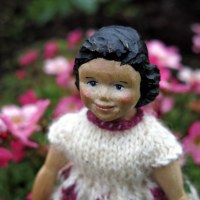Glimpses of Textiles in Old Novels
The Wide, Wide World by Susan Warner (1851) is the story of a young girl who is sent to live with an unwelcoming aunt, while her parents go to Europe hoping to return her mother to health. Ellen Montgomery finds life on the New England farm very different from her pampered upbringing.
From Chapter X
The coverlid of that came in for a share of her displeasure, being of homemade white and blue worsted, mixed with cotton, exceeding thick and heavy. ‘I wonder what sort of a blanket is under it,’ said Ellen, ‘if I can ever get it off to see! Pretty good; but the sheets are cotton, and so is the pillow-case!’
I guess she was expecting linen sheets and pillowcases!
Old coverlet of the type that did not meet with Miss Ellen’s approval.
Ellen is allowed a few days of freedom before her aunt expects her to help with farm work, and she immediately, while exploring, she gets her white stockings muddy. Her aunt takes all her other stockings except for one pair, and dyes them in a brass kettle with a piece of white maple bark.
Then tucking her up sleeves to the elbows, she fished up pair after pair out of the kettle, and writing them out, hung them on chairs to dry…they were no longer white, but of a fine slate color.
‘Well, how do you like that?’ said Miss Fortune, at length, when she had got two or three chairs round the fire, pretty well hung with a display of slate-colored cotton legs.
‘I don’t like it at all,’ said Ellen.
‘Well, I do. How many pair of white stockings would you like to drive into the mud, and let me wash out every week?’
‘You wash!’ said Ellen, in surprise. ‘I didn’t think of your doing it.’
‘Who did you think was going to do it? There’s nothing in this house but goes through my hand, I can tell you.”
Time goes by and Ellen meets the neighbors and learns to cope with country life. Her aunt is continually brusque with her and wants her to learn only practical skills instead of the “crinkum-crankums” of French, chemistry, and arithmetic. There is no school within walking distance, so Ellen tries to educate herself from books. About three-fourths of the way through the book, this conflict comes to a head over a spinning wheel. In the book, this is all written as one long paragraph, but I will break it up for you.
Embed from Getty ImagesFrom Chapter XL
The very next day Ellen was summoned to help her downstairs with the big spinning-wheel. Most unsuspiciously, and with her accustomed pleasantness, Ellen did it.
But when she was sent up again for the rolls of wool, and Miss Fortune, after setting up the wheel, put one of them into her hand and instructed her how to draw out and twist the thread of yarn, she saw all that was coming. She saw it with dismay.
How spinning works on a great wheel — the drive band from the wheel (here it is not in the proper position) turns the metal spindle quickly. Unspun fiber is held at an angle off the tip; the twist travels up and turns the loose fiber into a thread.
So much yarn as Miss Fortune might think it well she should spin, so much time must be taken daily from her beloved reading and writing, drawing, and studying; her very heart sunk with her. She made no remonstrance, unless her disconsolate face might be thought one; she stood half a day at the big spinning-wheel, fretting secretly, while Miss Fortune went round with an inward chuckle visible in her countenance, that in spite of herself increased Ellen’s vexation. And this was not the annoyance of a day; she must expect it day after day throughout the whole winter. It was a grievous trial. Ellen cried for a great while when she got to her own room; and a long hard struggle was necessary before she could resolve to do her duty. ‘To be patient and quiet! and spin nobody knows how much yarn and my poor history and philosophy and drawing and French and reading!’ Ellen cried very heartily. But she knew what she ought to do; she prayed long, humbly, earnestly, that ‘her little rushlight might shine bright;’ and her aunt had no cause to complain of her.
Sometimes, if over-pressed, Ellen would ask Miss Fortune to let her stop;… Miss Fortune never made any objection; and the hours of spinning that wrought so many knots* of yarn for her aunt, wrought better things yet for the little spinner; patience and gentleness grew with the practice of them; this wearisome work was one of the many seemingly untoward things which in reality bring out good. The time Ellen did secure to herself was held the more precious, and used the more carefully. After all it was a very profitable and pleasant winter to her.
(I do not know the source of this picture but it seems to be a pretty good illustration of Ellen’s attitude toward spinning.)
I enjoyed the parts of this book that explained how things were done in daily life. But as the excerpt above shows, those sections are interspersed with many many religious lessons, one in almost every chapter. And a lot of crying. One author counted “254 tear-flows in the 574 pages.” ** And, for a reader of the 21st century, way too much trusting of friendly strangers, and way too much caressing, hair-stroking, and embracing, by random acquaintances, to make for comfortable reading. So I did a lot of skimming.
The story echoes events in the author’s life, as I read in A Jury of Her Peers: American Women Writers from Anne Bradstreet to Annie Proulx, by Elaine Showalter. Susan Warner had lived a life of luxury, but her father lost her fortune in a financial panic in 1837, and the family had to move from New York City to a farmhouse, where they did their own housework and had to give up any attempt at fashion. In the book, Ellen finds herself laughed at for her unfashionable clothes. Her mother also provides her with a writing desk and sewing box, perfectly equipped with every possible accessory, things that author Susan Warner must have been wishing for.
In 1848, the situation became worse and they sold off most of their furniture and books. Susan and her sister Anna turned to writing to make money. (Anna was the author of the words of the song “Jesus Loves Me.”)
Showalter says, “Published under the pseudonym ‘Elizabeth Wetherell,’ The Wide, Wide World was the most celebrated domestic novel of the 1850s, going through thirteen editions in two years, selling over a million copies and probably causing much grinding of teeth among male novelists.” (p. 98) In comparison, Uncle Tom’s Cabin sold 305,000 copies in United States in its first year, and two million around the world.
I can see why this book has not remained as well-known as it was in the 1800s, but if you are interested in that era, it is worth skimming.
Notes:
The great wheel shown above is at the Institute for Texan Cultures in San Antonio.
*A knot is a term for 60 yards of wool or cotton. Two knots make one shift, seven shifts make one hank, 18 hanks make one spindle. From The Shuttle-Craft Book of American Hand-weaving by Mary Meigs Atwater, p. 67.
**Fred Pattee, quoted in A Jury of Her Peers



















It sounds a hard read but very interesting. I would sooner have done the mud and the spinning than the studying! Thanks again for the interesting post.
I can see you out there exploring! It does seem funny that she was so determined to learn French and Italian when she lived in the boondocks of New England.
I agree – I’d rather do the spinning than the studying! A fascinating post – I wonder how many other novels would yield this sort of information on everyday textiles? And all those tears …..oh, deary me, how damp 😦
Little glimpses of textile information pop up in a lot of these old books, but not as much as information on food or transportation. Still, I am always glad to find them! Even if I have to wade through lots of tears and morals to find them. 🙂
Poor Ellen! A young woman of that era who wanted to develop her mind had an uphill battle! Funny the connections here–I went to Penn State and Fred Pattee, whom you quote, was a prof there and wrote the words to our alma mater. The library where I spent ALL my time, developing my own mind, was named after him.
I had checked the footnote on that quote, and saw that the title of Pattee’s book was The Feminine Fifties, so I was assuming he was a recent author. Then after your comment, I looked him up and saw that he died in 1954, and that book was published in 1940, so it was referring to the 1850s! not the 1950s. It would be an interesting read!
Poor Ellen, indeed. Like any female, she needed to be taught a lesson in as smug a manner as possible. Yes, she probably was a bit spoiled when she came to the farm and needed a reality check about life on a farm. But her attempts to educate herself are presented as almost a dirty secret to be squeezed in between all her chores, praying and crying. Far better to learn those feminine virtues of patience and gentleness. My mother used to drive me crazy by quoting, “Be good, sweet maid, and let who will be clever.”
Well it all comes out fine in the end when a brother and sister team befriend her, and then the sister dies very conveniently, and of course the brother marries her! How many stories do we have where we have to be rescued???? It’s no wonder everyone was ready for Jo March when Little Women was published 17 years later!!
Jo was my childhood heroine, and she plays a role in Elena Ferrante’s first volume of her Naples trilogy that’s getting so much press lately.
So much to uncover about history through the craft of spinning and weaving. Fantastic post.
Yes, and I think with stories written in a past era, you find out so many unexpected details about history, rather than reading historical fiction written in our own time, although that is better at giving the big picture. Glad you liked it!
Interesting details….no work no food………….. Congratulations on slogging thru it. not sure I would have.
Yes, Ellen was at her aunt’s house for quite a while before she even figured out that something as simple as clearing the dishes did not get done by itself. I did make it all the way through, more to see if the tears and moral lessons ever decreased in the least than to find out what happened to her. But I would say I just read one page out of three.
Times back then were mighty hard I’m sure, especially coming from a culture where it was so much easier. I agree it must have been a hard read. I’d of probably read every other chapter!
If I were expected to spend half a day spinning, I might cry, too. That’s a long time.
Pingback: Glimpses of Textiles in Old Novels, Part Two | Deep in the Heart of Textiles